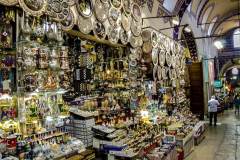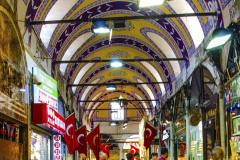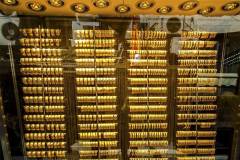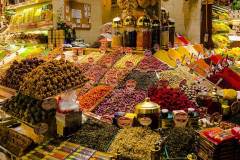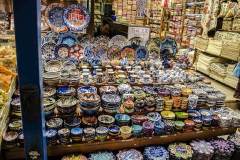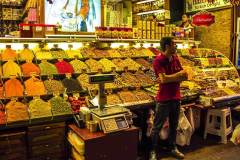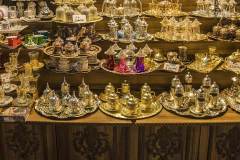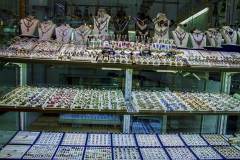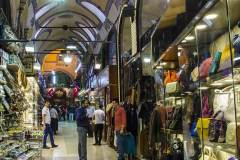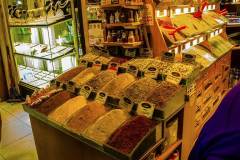Location: Istanbul Turkey
Completion date: After 1730
Beginning date: 1455
The Grand Bazaar is one of Istanbul’s most famous and popular attractions, drawing visitors from all over the world who come to experience its vibrant atmosphere and unique shopping opportunities. With over 4,000 shops and covering an area of 61 streets, the Grand Bazaar is one of the world’s largest and oldest covered markets.
The bazaar dates back to the 15th century when it was established as a trading center for textiles and spices. Over the years, it has expanded to include a wide range of goods, from jewelry and ceramics to carpets and leather goods. Today, it is a bustling hub of activity, with vendors selling their wares and shoppers haggling over prices.
One of the most exciting things about the Grand Bazaar is the sheer variety of items on offer. Visitors can browse through shops selling everything from traditional Turkish lamps and tea sets to modern clothing and souvenirs. The bazaar is also famous for its gold and silver jewelry, with many shops offering custom designs and intricate pieces.
In addition to shopping, the Grand Bazaar is a cultural experience in its own right. Visitors can admire the beautiful Ottoman-era architecture, with its colorful tiles and ornate carvings, and take in the sights and sounds of the bustling market. The bazaar is also home to several mosques and fountains, adding to its historical and cultural significance.
Navigating the Grand Bazaar can be overwhelming, but it’s all part of the experience. Visitors should be prepared to haggle over prices and take their time exploring the many shops and stalls. It’s also a good idea to bring cash, as many vendors don’t accept credit cards.
Overall, the Grand Bazaar is a must-visit destination for anyone traveling to Istanbul. It’s a vibrant and exciting market that offers a glimpse into Turkish culture and history, as well as some of the best shopping opportunities in the city.
The Grand Bazaar history
The Grand Bazaar, also known as Kapalıçarşı in Turkish, is one of the oldest and largest covered markets in the world. It was established in the 15th century after the Ottoman Sultan Mehmed II conquered Constantinople (now Istanbul) and decided to build a large marketplace to stimulate the city’s economy.
The Grand Bazaar was originally built as a covered complex of two bedestens (domed structures), which served as trading centers for textiles and spices. Over the years, additional structures were added, and the bazaar grew to become a sprawling maze of shops and stalls covering an area of over 30,000 square meters.
Throughout its history, the Grand Bazaar has played a significant role in the city’s economic and cultural life. It has been a center of trade, commerce, and craftsmanship, attracting merchants and artisans from all over the world. The bazaar has also been a hub of social activity, with locals and visitors alike gathering to shop, socialize, and exchange ideas.
The Grand Bazaar has undergone several renovations and expansions over the centuries, with the most significant renovations taking place in the 16th and 19th centuries. During the Ottoman era, the bazaar was an important center of trade, with goods from all over the empire passing through its doors. In the 20th century, the bazaar became a popular tourist attraction, drawing visitors from all over the world who come to experience its unique atmosphere and shop for Turkish souvenirs.
Today, the Grand Bazaar is one of Istanbul’s most famous landmarks and a must-visit destination for anyone traveling to the city. It is home to over 4,000 shops and attracts an estimated 250,000 visitors every day, making it one of the world’s most visited tourist attractions. Despite its age and size, the bazaar remains a vibrant and exciting marketplace, a living testament to Istanbul’s rich cultural and historical heritage.
The Grand Bazaar (Turkish: Kapalıçarşı, meaning ‘Covered Market’; also Büyük Çarşı, meaning ‘Grand Market’) in Istanbul is one of the largest and oldest covered markets in the world, with 61 covered streets and over 4,000 shops on a total area of 30,700 m2, attracting between 250,000 and 400,000 visitors daily.
One of the largest and oldest covered bazaars in the world, the Grand Bazaar is 30,700 square meters with over 60 streets and alleys and 4,000 shops. The original historical core of the bazaar, İç Bedesten, was completed by Mehmet the Conqueror in 1461. A “bedesten” refers to an indoor arcade with shops and there are several areas within the bazaar referred to by this name.
Over the years, the Grand Bazaar expanded from this core of two bedestens to become a sprawling roofed complex of thousands of shops, fringed by the tradesmen’s inns and workshops known as hans. According to the Ottoman traveler Evliya Çelebi’s Seyahatname, by the seventeenth century the Kapalı Çarşı (or the Çarşı-yı-Kebir as it was known at the time) had reached its present size, with over 4,000 shops and nearly 500 stalls known in Turkish as dolap (literally translated to “cupboard”).
In addition, there were various other amenities for the merchants who worked there: restaurants, a hammam, and a mosque, as well as at least 10 smaller mescits, or prayer rooms. Today, this city-within-a-city contains a police station, a health dispensary, a post office, branches of most major banks, and a tourist information center.
In comparison with street names in the English-speaking world, those in Turkey are often very descriptive. The street names in the Grand Bazaar—referring to their original functions—are no exception. Takkeciler Caddesi is literally “Skullcap-makers’ Street” as takke means skullcap; Aynacılar Sokak was for sellers of ayna, or mirrors; Halıcılar Caddesi was where halı, or carpets, were sold; and Keseciler Caddesi was for vendors of the kese, the rough exfoliating cloth used in a hammam.
While today the Grand Bazaar is no longer the commercial center of Istanbul, it is still one of the best places to get a taste of life in Ottoman-era Turkey.






